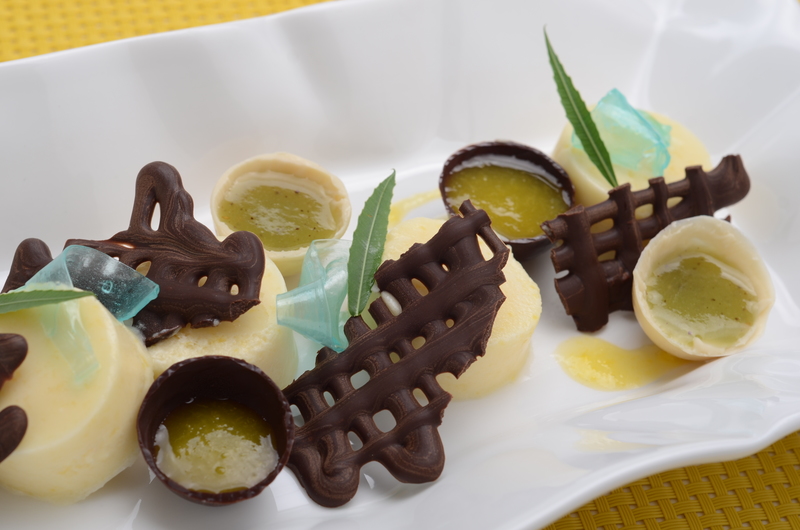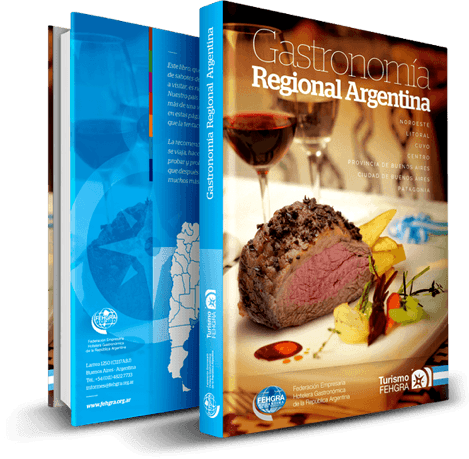Una delicia bien variada: mousse de kinotos especiada con cardamomo, que contrasta con el enrejado de chocolate al que el curaçao de kiwi y durazno le dan un sabor especial.

para 3 porciones
| 1 g. | GELATINA S/SABOR |
| 25 g. | MERENGUE SUIZO |
| 25 g. | CREMA DE LECHE |
| 50 g. | MERMELADA DE KINOTOS |
ALMIBAR
| 100 g. | LICOR DE CURACAO |
| 15 g. | AZÚCAR |
COULIS DE DURANZO
| 1 unidad | DURAZNOS EN ALMÍBAR |
COULIS DE KIWI
| 60 g. | PULPA DE KIWI |
| 50 g. | AZÚCAR |
| 50 ml. | AGUA |
ENREJADO DE CHOCOLATE
| 50 g. | CHOCOLATE SEMI-AMARGO PREVIAMENTE TEMPLADO |
ENCAPSULADO DE CURACAO
| 100 g. | FONDANT |
| 50 g. | GLUCOSA |
| c/n | TINTURA VEGETAL |
DECORACIÓN
ZETS DE CHOCOLATE SEMI-AMARGO |
Procesar la mermelada y reservar. Montar la crema de leche hasta 3/4 pto. y reservar. Realizar un merengue suizo con dos claras y 150 gramos de azúcar. Unir en forma envolvente la mermelada con la crema montada. Luego agregar el merengue suizo en forma envolvente. Agregar la gelatina previamente hidratada. Colocar en molde y refrigerar por un tiempo mínimo de una hora.
Almíbar de curaçao Colocar ambos ingredientes en una olla y calentar hasta 104ºC, reserar hasta que enfríe.
Coulis de durazno Mixar los duraznos hasta que quede hecho un puré de textura lisa y reservar.
Coulis de Kiwi Realizar un almíbar con el azúcar y el agua, calentar hasta 180ºC, luego dejar enfriar. Una vez frio el almibar, incorporarlo a la pulpa de kiwi y mixar todo hasta obtener un puré de textura lisa.
Encapsulado de curaçao Realizar una media esfera de chocolate con un molde para bombones, desmoldar y rellenar con el almíbar de curaçao.
Enrejado de chocolate Fundir el chocolate, y sobre papel manteca realizar pequeñas rejas para decorar.
Caramelo de curaçao Calentar el fondant y la glucosa hasta 155ºC, retirar del fuego y teñir si fuese necesario. Volcar sobre papel siliconado. Espatular, dejar enfriar y quebrar en trozos pequeños para decorar.
Emplatado Desmoldar la mousse, colocar en un plato rectangular, salsear con el coulis de durazno y el de kiwi. Agregar a los costados de la mousse el encapsulado de curaçao y decorar con las rejas de chocolate y el caramelo de curaçao.
La región es famosa por sus cítricos. En ella abundan los kinotos o quinotos, también conocidos como naranjo enano. La fruta, a pesar de haber llegado de la mano europea, tuvo su origen en China, donde se la conoce como naranja dorada. Por su grado de acidez, es común prepararlo en almíbar.

“Este libro, que es un gran mapa de sabores de regiones argentinas a visitar, es rico y variado.”
Conocé más sobre el libro original.
Acerca del libro